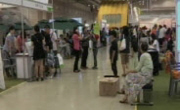This thesis treats the nationalistic and social movement by Gang-Ha Lee from late 1910s to late 1920s. The nationalistic movement by Gang-Ha Lee had continued until his death for 10 years. He acted as and passed through nationalism, anarchism and soci...
http://chineseinput.net/에서 pinyin(병음)방식으로 중국어를 변환할 수 있습니다.
변환된 중국어를 복사하여 사용하시면 됩니다.
- 中文 을 입력하시려면 zhongwen을 입력하시고 space를누르시면됩니다.
- 北京 을 입력하시려면 beijing을 입력하시고 space를 누르시면 됩니다.
https://www.riss.kr/link?id=A104573847
-
저자
허종 (충남대학교)
- 발행기관
- 학술지명
- 권호사항
-
발행연도
2009
-
작성언어
Korean
-
주제어
Daejeon ; Nationalistic movement ; Peasant movement ; Youth movement ; Provisional government ; Anarchism ; Socialism ; 대전 ; 민족운동 ; 농민운동 ; 청년운동 ; 임시정부 ; 아나키즘 ; 사회주의
-
등재정보
KCI등재
-
자료형태
학술저널
-
수록면
152-180(29쪽)
-
KCI 피인용횟수
0
- 제공처
- 소장기관
-
0
상세조회 -
0
다운로드
부가정보
다국어 초록 (Multilingual Abstract)
The nationalistic movement by Gang-Ha Lee had continued until his death for 10 years. He acted as and passed through nationalism, anarchism and socialism. His recognition and strategem changed in the course of action and it was the result of intense worrying of nationalistic movement. Through such process, he acted with high level of concept of nationalistic movement and realistic recognition. The recognition of Gang-Ha Lee led to an active and vigorous nationalistic movement. His nationalistic movement began with 3‧1 independence movement in 1919. Afterwards he joined a secret society that was supporting the provisional government. In the early 1920, he recognized the limit of nationalistic movement, accepted anarchism and was active in Japan and Korea. He joined Heukdo Society, a Korean ideological organization, and was active in protecting the interests of Korean laborers in Japan. After returning to homeland, he developed peasant movement in Daejeon, his hometown. Daejeon had not seen any peasant movement until his activity. In the process, new activists were trained and the local residents’ nationalistic and social consciousness was enhanced.
He accepted the socialism and was active in the process that activists were differentiated according to ideology of nationalistic movement in the mid-1920s. He formed a real youth organization to innovate the stagnant youth movement together with young activists and that became the base on which the local youth movement was activated. He also took the leading role in renovating the existing peasant organization, separating organizations with an ambiguous character and forming new organizations to escape the inactive peasant movement. His activity resulted in the activation of nationalistic and social movement in Daejeon area. In conclusion, his recognition and practice of nationalistic movement can be an example to show a model of activist who was making efforts to cope with the colonial reigning system.
This thesis treats the nationalistic and social movement by Gang-Ha Lee from late 1910s to late 1920s.
The nationalistic movement by Gang-Ha Lee had continued until his death for 10 years. He acted as and passed through nationalism, anarchism and socialism. His recognition and strategem changed in the course of action and it was the result of intense worrying of nationalistic movement. Through such process, he acted with high level of concept of nationalistic movement and realistic recognition. The recognition of Gang-Ha Lee led to an active and vigorous nationalistic movement. His nationalistic movement began with 3‧1 independence movement in 1919. Afterwards he joined a secret society that was supporting the provisional government. In the early 1920, he recognized the limit of nationalistic movement, accepted anarchism and was active in Japan and Korea. He joined Heukdo Society, a Korean ideological organization, and was active in protecting the interests of Korean laborers in Japan. After returning to homeland, he developed peasant movement in Daejeon, his hometown. Daejeon had not seen any peasant movement until his activity. In the process, new activists were trained and the local residents’ nationalistic and social consciousness was enhanced.
He accepted the socialism and was active in the process that activists were differentiated according to ideology of nationalistic movement in the mid-1920s. He formed a real youth organization to innovate the stagnant youth movement together with young activists and that became the base on which the local youth movement was activated. He also took the leading role in renovating the existing peasant organization, separating organizations with an ambiguous character and forming new organizations to escape the inactive peasant movement. His activity resulted in the activation of nationalistic and social movement in Daejeon area. In conclusion, his recognition and practice of nationalistic movement can be an example to show a model of activist who was making efforts to cope with the colonial reigning system.
다국어 초록 (Multilingual Abstract)
The nationalistic movement by Gang-Ha Lee had continued until his death for 10 years. He acted as and passed through nationalism, anarchism and socialism. His recognition and strategem changed in the course of action and it was the result of intense worrying of nationalistic movement. Through such process, he acted with high level of concept of nationalistic movement and realistic recognition. The recognition of Gang-Ha Lee led to an active and vigorous nationalistic movement. His nationalistic movement began with 3‧1 independence movement in 1919. Afterwards he joined a secret society that was supporting the provisional government. In the early 1920, he recognized the limit of nationalistic movement, accepted anarchism and was active in Japan and Korea. He joined Heukdo Society, a Korean ideological organization, and was active in protecting the interests of Korean laborers in Japan. After returning to homeland, he developed peasant movement in Daejeon, his hometown. Daejeon had not seen any peasant movement until his activity. In the process, new activists were trained and the local residents’ nationalistic and social consciousness was enhanced.
He accepted the socialism and was active in the process that activists were differentiated according to ideology of nationalistic movement in the mid-1920s. He formed a real youth organization to innovate the stagnant youth movement together with young activists and that became the base on which the local youth movement was activated. He also took the leading role in renovating the existing peasant organization, separating organizations with an ambiguous character and forming new organizations to escape the inactive peasant movement. His activity resulted in the activation of nationalistic and social movement in Daejeon area. In conclusion, his recognition and practice of nationalistic movement can be an example to show a model of activist who was making efforts to cope with the colonial reigning system.
This thesis treats the nationalistic and social movement by Gang-Ha Lee from late 1910s to late 1920s. The nationalistic movement by Gang-Ha Lee had continued until his death for 10 years. He acted as and passed through nationalism, anarchism and soc...
This thesis treats the nationalistic and social movement by Gang-Ha Lee from late 1910s to late 1920s.
The nationalistic movement by Gang-Ha Lee had continued until his death for 10 years. He acted as and passed through nationalism, anarchism and socialism. His recognition and strategem changed in the course of action and it was the result of intense worrying of nationalistic movement. Through such process, he acted with high level of concept of nationalistic movement and realistic recognition. The recognition of Gang-Ha Lee led to an active and vigorous nationalistic movement. His nationalistic movement began with 3‧1 independence movement in 1919. Afterwards he joined a secret society that was supporting the provisional government. In the early 1920, he recognized the limit of nationalistic movement, accepted anarchism and was active in Japan and Korea. He joined Heukdo Society, a Korean ideological organization, and was active in protecting the interests of Korean laborers in Japan. After returning to homeland, he developed peasant movement in Daejeon, his hometown. Daejeon had not seen any peasant movement until his activity. In the process, new activists were trained and the local residents’ nationalistic and social consciousness was enhanced.
He accepted the socialism and was active in the process that activists were differentiated according to ideology of nationalistic movement in the mid-1920s. He formed a real youth organization to innovate the stagnant youth movement together with young activists and that became the base on which the local youth movement was activated. He also took the leading role in renovating the existing peasant organization, separating organizations with an ambiguous character and forming new organizations to escape the inactive peasant movement. His activity resulted in the activation of nationalistic and social movement in Daejeon area. In conclusion, his recognition and practice of nationalistic movement can be an example to show a model of activist who was making efforts to cope with the colonial reigning system.
참고문헌 (Reference)
1 박걸순, 국가보훈처 1999
2 姜德相梶村壽秀, "현대사자료 29" みすず書房 1972
3 이현주, "해방 전후 통일운동의 전개와 시련" 지식산업사 2008
4 이호룡, "한국의 아니키즘-사상편" 지식산업사 2001
5 김명섭, "한국 아나키스트들의 독립운동" 이학사 2008
6 "중외일보"
7 "조선일보"
8 조종섭, "일제하 대전지역의 청년운동" 6 (6): 1998
9 "매일신보"
10 "동아일보"
1 박걸순, 국가보훈처 1999
2 姜德相梶村壽秀, "현대사자료 29" みすず書房 1972
3 이현주, "해방 전후 통일운동의 전개와 시련" 지식산업사 2008
4 이호룡, "한국의 아니키즘-사상편" 지식산업사 2001
5 김명섭, "한국 아나키스트들의 독립운동" 이학사 2008
6 "중외일보"
7 "조선일보"
8 조종섭, "일제하 대전지역의 청년운동" 6 (6): 1998
9 "매일신보"
10 "동아일보"
11 장석흥, "대한민국청년외교단 연구" (2) : 1988
12 "대구형무소, 재소자 신분카드(1921)"
13 "대구지방법원 형사부, 이강하 판결문(1920.9.7)"
14 "黑濤"
15 "現社會"
16 金正明, "朝鮮獨立運動 제1권 분책" 原書房 1967
17 "倭政時代 人物史料"
18 국학자료원, "三一運動 編(1)" 국학자료원 1996
19 "フテイ鮮人"
20 전명혁, "1920년대 한국사회주의운동연구" 선인 2006
21 허종, "1920년대 대전지역의 청년운동" 대구사학회 88 : 33-66, 2007
22 오대록, "1920년대 ‘全北民衆運動者同盟’ 연구" 한국근현대사학회 (41) : 62-94, 2007
동일학술지(권/호) 다른 논문
-
서평 : 격동기(1900~1950) 서양인들의 한국 내 활동에 대한 추적
- 한국근현대사학회
- 안종철
- 2009
- KCI등재
-
- 한국근현대사학회
- 김희곤
- 2009
- KCI등재
-
20세기 초 間島 朝鮮人 民族敎育운동의 전개와 중국의 對朝鮮人 교육정책
- 한국근현대사학회
- 박금해
- 2009
- KCI등재
-
정부수립과 한국근현대사 속에서 광복·건국의 연속과 단절
- 한국근현대사학회
- 신주백
- 2009
- KCI등재
분석정보
인용정보 인용지수 설명보기
학술지 이력
| 연월일 | 이력구분 | 이력상세 | 등재구분 |
|---|---|---|---|
| 2026 | 평가예정 | 재인증평가 신청대상 (재인증) | |
| 2020-01-01 | 평가 | 등재학술지 유지 (재인증) |  |
| 2017-01-01 | 평가 | 등재학술지 유지 (계속평가) |  |
| 2013-01-01 | 평가 | 등재학술지 유지 (등재유지) |  |
| 2010-01-01 | 평가 | 등재학술지 유지 (등재유지) |  |
| 2008-01-01 | 평가 | 등재학술지 유지 (등재유지) |  |
| 2005-01-01 | 평가 | 등재학술지 선정 (등재후보2차) |  |
| 2004-01-01 | 평가 | 등재후보 1차 PASS (등재후보1차) |  |
| 2003-01-01 | 평가 | 등재후보학술지 선정 (신규평가) |  |
학술지 인용정보
| 기준연도 | WOS-KCI 통합IF(2년) | KCIF(2년) | KCIF(3년) |
|---|---|---|---|
| 2016 | 0.66 | 0.66 | 0.71 |
| KCIF(4년) | KCIF(5년) | 중심성지수(3년) | 즉시성지수 |
| 0.65 | 0.62 | 1.675 | 0.11 |




 스콜라
스콜라







